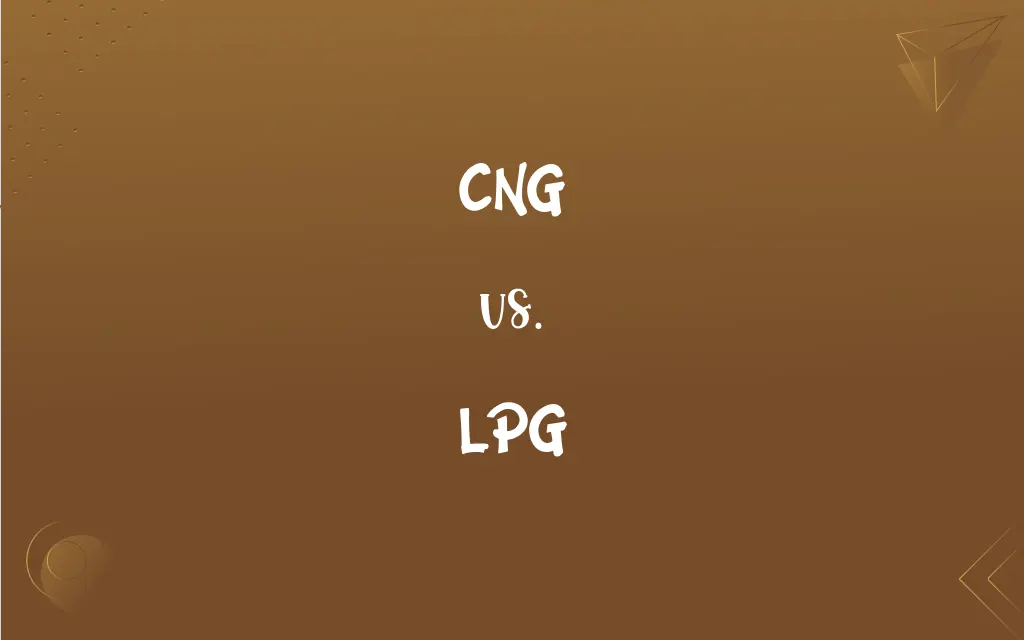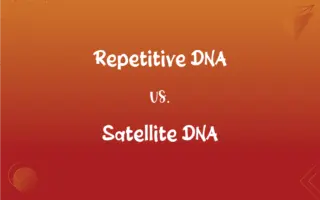CNG vs. LPG: What's the Difference?
Edited by Aimie Carlson || By Harlon Moss || Published on January 3, 2024
CNG (Compressed Natural Gas) is primarily methane, stored under high pressure, cleaner-burning; LPG (Liquefied Petroleum Gas) is propane or butane, stored as a liquid, more energy-dense.

Key Differences
CNG, or Compressed Natural Gas, is mainly composed of methane, derived from natural gas wells and renewable sources. LPG, or Liquefied Petroleum Gas, contains propane, butane, or a blend of these gases, and is a byproduct of natural gas processing and petroleum refining.
CNG is stored under high pressure in a gaseous state, which requires sturdy, high-pressure containers. LPG, in contrast, is stored under pressure in a liquid form, allowing it to be stored in a greater amount in a smaller volume.
Both CNG and LPG are used as fuels but have different applications. CNG is primarily used in transportation, industrial, and residential heating. LPG is widely used for cooking, heating, and in vehicles, especially where piped natural gas is unavailable.
CNG is considered cleaner than LPG due to its lower carbon content, producing less carbon dioxide and pollutants upon combustion. LPG, while cleaner than other fossil fuels, has a higher carbon content than CNG, leading to greater CO2 emissions.
LPG has a higher energy content than CNG, making it more efficient in terms of energy per unit volume. However, the cost and availability can vary depending on location, with CNG generally being cheaper in regions with abundant natural gas.
ADVERTISEMENT
Comparison Chart
Main Component
Methane
Propane or Butane
State at Room Temperature
Gas
Liquid
Storage Pressure
High Pressure
Lower Pressure than CNG
Environmental Impact
Lower CO2 Emissions
Higher CO2 Emissions than CNG
Common Uses
Transportation, Heating
Cooking, Heating, Vehicles
ADVERTISEMENT
CNG and LPG Definitions
CNG
Methane-based fuel stored under high pressure.
CNG tanks are heavier and require more space than traditional fuel tanks.
LPG
A cleaner alternative to gasoline and diesel, though with higher emissions than CNG.
Some vehicles have been converted to run on LPG for environmental benefits.
CNG
A clean-burning alternative fuel sourced from natural gas.
The city's bus fleet was converted to run on CNG to reduce emissions.
LPG
A byproduct of natural gas processing and petroleum refining.
The refinery produces LPG as one of its many petroleum products.
CNG
A fossil fuel in gaseous form used for transportation and heating.
Many taxis in the city use CNG due to its cost-effectiveness.
LPG
A versatile fuel commonly used for cooking and heating.
Rural homes often rely on LPG cylinders for their cooking needs.
CNG
A gas used in compressed form for energy purposes.
Industries are increasingly adopting CNG for its economic benefits.
LPG
A blend of propane and butane stored as a liquid under pressure.
LPG tanks are commonly seen in backyard grills.
CNG
Eco-friendly fuel choice with lower greenhouse gas emissions.
CNG is gaining popularity as a green alternative to gasoline.
LPG
An energy-dense fuel suitable for storage and transport.
LPG is popular in areas without natural gas pipelines.
FAQs
What is LPG?
LPG stands for Liquefied Petroleum Gas, a mix of propane and butane, used as fuel.
How is CNG stored?
CNG is stored under high pressure in a gaseous state.
What is CNG?
CNG stands for Compressed Natural Gas, primarily methane, used as a fuel.
How is LPG stored?
LPG is stored under pressure as a liquid.
What are the main uses of CNG?
CNG is mainly used in vehicles, heating, and industrial processes.
Is CNG environmentally friendly?
Yes, CNG burns cleaner than many other fuels, with lower emissions.
Is LPG environmentally friendly?
LPG is cleaner than traditional fuels but has higher emissions than CNG.
Can CNG be used in all vehicles?
Not all vehicles; some require specific CNG conversion kits.
Can LPG be used in all vehicles?
Not all; vehicles need special modifications to use LPG.
How does the cost of CNG compare to LPG?
CNG is often cheaper than LPG, depending on local availability and infrastructure.
Which is more energy-efficient, CNG or LPG?
LPG has a higher energy content per volume than CNG.
Is CNG safer than LPG?
Both have safety risks, but CNG is less dense than air and disperses quickly, reducing some risks.
Is LPG safer than CNG?
LPG, being heavier than air, poses different safety risks.
Is CNG available everywhere?
Its availability varies by region, depending on natural gas infrastructure.
Is LPG available everywhere?
LPG is more widely available, especially in areas without natural gas pipelines.
Can CNG and LPG be used interchangeably?
No, they require different handling, storage, and engine modifications.
Are there government incentives for using CNG or LPG?
Many regions offer incentives for using these cleaner fuels, varying by location.
What are the main uses of LPG?
LPG is mainly used for cooking, heating, and in vehicles.
What is the impact of CNG and LPG on engine life?
Both can extend engine life due to cleaner burning, but require compatible engine types.
How do CNG and LPG impact global warming?
Both have lower greenhouse gas emissions compared to gasoline and diesel, with CNG being the cleaner option.
About Author
Written by
Harlon MossHarlon is a seasoned quality moderator and accomplished content writer for Difference Wiki. An alumnus of the prestigious University of California, he earned his degree in Computer Science. Leveraging his academic background, Harlon brings a meticulous and informed perspective to his work, ensuring content accuracy and excellence.
Edited by
Aimie CarlsonAimie Carlson, holding a master's degree in English literature, is a fervent English language enthusiast. She lends her writing talents to Difference Wiki, a prominent website that specializes in comparisons, offering readers insightful analyses that both captivate and inform.






































































